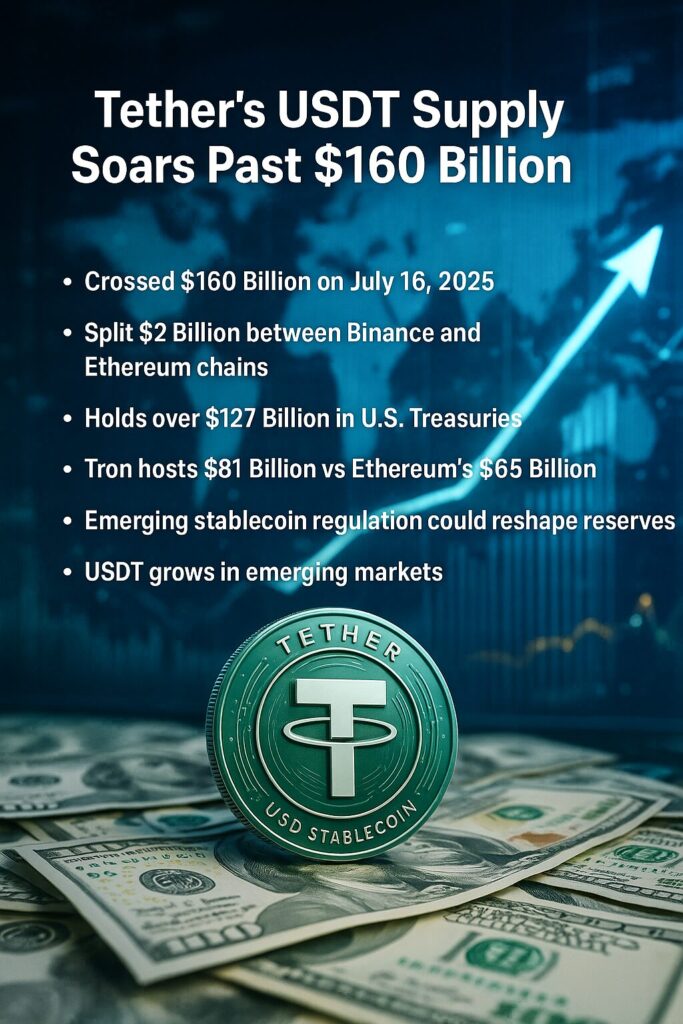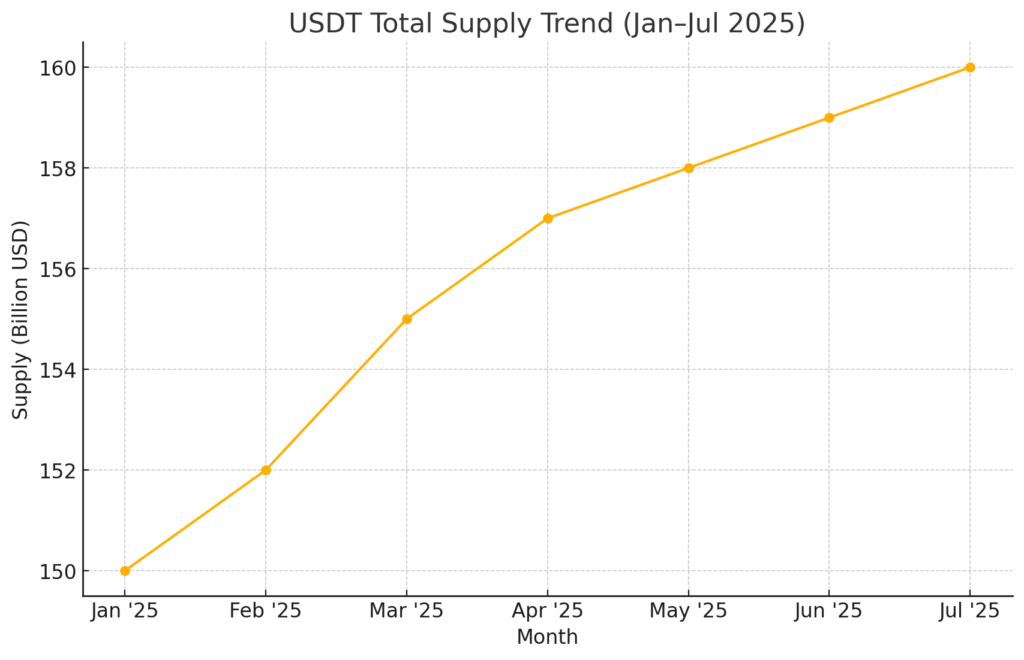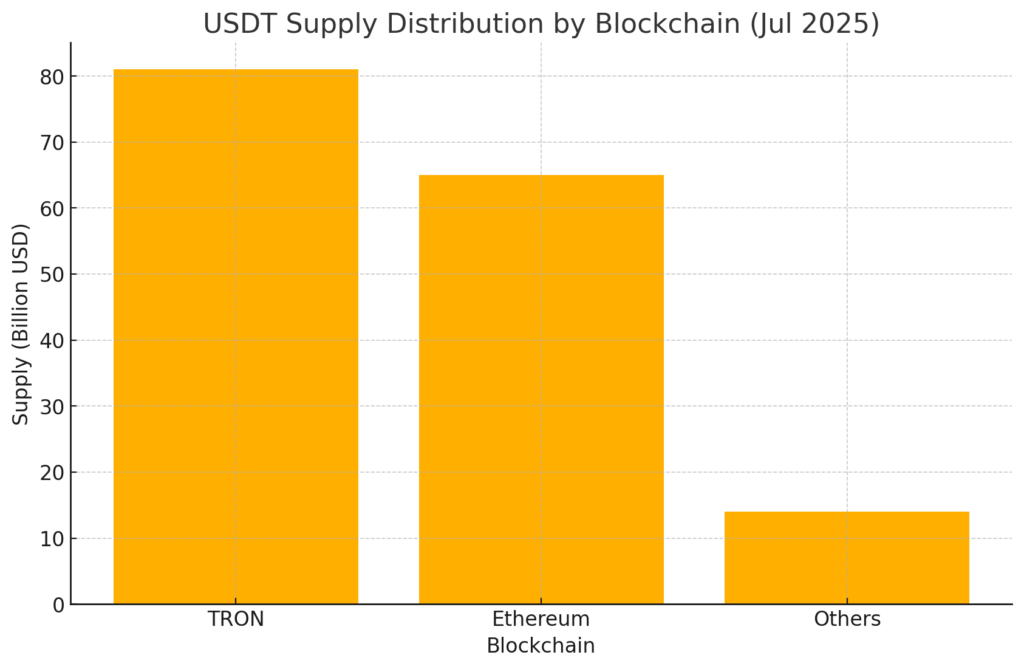
Main Points:
- Record Supply Issuance: Tether minted an additional $2 billion USDT on July 16, pushing total supply past $160 billion for the first time.
- Strategic Inventory Management: The new tokens serve as “inventory replenishment” on Ethereum, not immediate market injection.
- Blockchain Distribution Shift: Tron now hosts approximately $81 billion USDT, outpacing Ethereum’s $65 billion.
- Robust Treasury Backing: Tether’s Q2 2025 report shows over $127 billion in U.S. Treasuries, equivalent to the holdings of a medium-sized sovereign.
- Emerging Market Adoption: CEO Paolo Ardoino emphasized USDT’s growing role as a “digital dollar” in emerging economies.
- Regulatory Outlook: The recently passed GENIUS Act and CLARITY Act in the U.S. Congress will shape stablecoin frameworks and digital asset jurisdiction


1. Record Supply Issuance
On July 16, 2025, Tether minted $2 billion new USDT, driving its total supply beyond $160 billion—an all-time high. According to CEO Paolo Ardoino, this issuance represents a strategic “inventory replenishment” on the Ethereum blockchain, intended to meet anticipated future demand rather than immediate market circulation. Notably, $1 billion of the newly minted tokens was transferred to Binance, signaling preparations for elevated trading activity across major venues. As stablecoins underpin much of cryptocurrency liquidity, this expansion underscores USDT’s dominant role in digital finance.
2. Strategic Inventory Management
Tether’s approach to minting emphasizes readiness over reactive issuance. By holding freshly minted USDT as “inventory” on Ethereum, Tether ensures swift distribution to exchanges and DeFi platforms when on-chain demand surges. This model reduces the latency and friction of on-demand minting, which historically risked network congestion and price slippage. Moreover, by pre-positioning liquidity, Tether can respond to large-scale market events—such as major token listings or macroeconomic shocks—without delay, bolstering USDT’s reliability in fast-moving markets.
3. Blockchain Distribution Shift
While Ethereum long led in USDT hosting, Tron has surged ahead. As of July 2025, the Tron network carries roughly $81 billion of USDT, with Ethereum at $65 billion and other chains accounting for the remaining $14 billion. This shift reflects Tron’s lower fees and higher throughput, which appeal to high-volume traders and DeFi protocols.
4. Robust Treasury Backing
Tether maintains that each USDT is backed 1:1 by reserves. Q2 2025 attestation reports reveal $127 billion+ in U.S. Treasury holdings—equivalent to the 18th-largest government holder globally. With cash equivalents and short-term Treasuries comprising over 80% of reserves, Tether positions itself as a secure issuer amid concerns over stablecoin collateralization practices. Such scale in government debt holdings underscores institutional confidence in Tether’s financial governance.
5. Emerging Market Adoption
CEO Ardoino highlights USDT’s critical role as a “digital dollar” in emerging markets, where local currencies face volatility and remittance corridors demand efficient dollar-pegged instruments. In countries with strict capital controls or high inflation, USDT facilitates cross-border transactions, payroll distribution, and DeFi access—effectively extending U.S. dollar utility without traditional banking infrastructure. This utility drives continued USDT demand and underpins Tether’s supply growth strategy.
6. Regulatory Outlook
On July 17, 2025, the U.S. House passed the GENIUS Act, setting a federal-state framework for stablecoin issuance, reserve requirements, and audit obligations. Simultaneously, the CLARITY Act clarifies SEC versus CFTC jurisdiction over digital assets .
- GENIUS Act: Requires stablecoins backed by liquid reserves, mandates monthly disclosure, and allows banks, credit unions, and approved nonbanks to issue payment stablecoins.
- CLARITY Act: Distinguishes “digital commodities” under CFTC oversight and “digital securities” under SEC, reducing jurisdictional ambiguity for tokens like USDT.
These laws, pending presidential signature and regulatory rule-making, will reshape how Tether and peers operate in the U.S., potentially influencing collateral standards, transparency mandates, and cross-border compliance.
Conclusion
Tether’s breakthrough of $160 billion in USDT supply cements its position as the linchpin of crypto liquidity, backed by unparalleled Treasury reserves and distributed across diverse blockchains. As Tron’s rise illustrates user preferences for speed and cost efficiency, Tether’s strategic minting and inventory model ensures market responsiveness. With global adoption accelerating—especially in emerging markets—and an evolving regulatory framework poised to impose new standards, USDT’s future will hinge on balancing growth, transparency, and compliance. For crypto investors and practitioners, understanding these dynamics is key to leveraging USDT as a stable, scalable “digital dollar” in an increasingly tokenized financial ecosystem.

